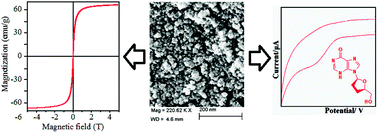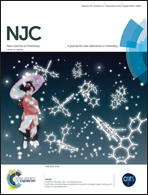Investigation of magnetic and electrochemical sensing properties of novel Ba1/3Mn1/3Co1/3Fe2O4 nanoparticles
Abstract
Novel Ba1/3Mn1/3Co1/3Fe2O4 nanoparticles were successfully synthesized using the glycol thermal route. The X-ray diffraction study confirmed a well defined spinel phase structure of the sample. The microstrain was investigated based on the Williamson–Hall plot. Crystallinity, shape and size of the nanoparticles were studied using high resolution transmission electron microscopy and high resolution scanning electron microscopy. Brunauer–Emmet–Teller measurement revealed that the sample has a high surface area of 116 m2 g−1. The Barrett–Joyner–Halenda test showed that the sample is mesoporous. The magnetization was found to increase from 66.5 ± 0.3 emu g−1 at 300 K to 84.4 ± 0.5 emu g−1 at 4 K. Furthermore, the electrochemical sensing properties of Ba1/3Mn1/3Co1/3Fe2O4 nanoparticles were investigated using cyclic voltammetry. A glassy carbon electrode was modified using the synthesized Ba1/3Mn1/3Co1/3Fe2O4 nanoparticles. The modified electrode demonstrated excellent electrocatalytic activity towards didanosine, an anti-HIV drug. A linear response to the drug concentration was obtained in the range from 0.001 to 5.0 μM with a detection limit of 1.0 nM. The electrode was highly stable, reproducible and was successfully used to determine trace amounts of didanosine in human urine samples.


 Please wait while we load your content...
Please wait while we load your content...